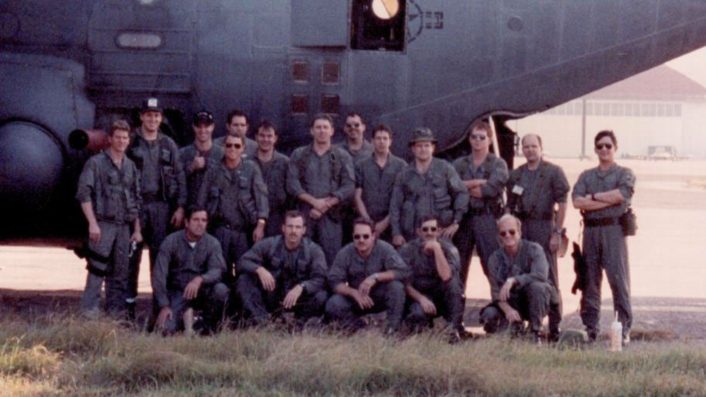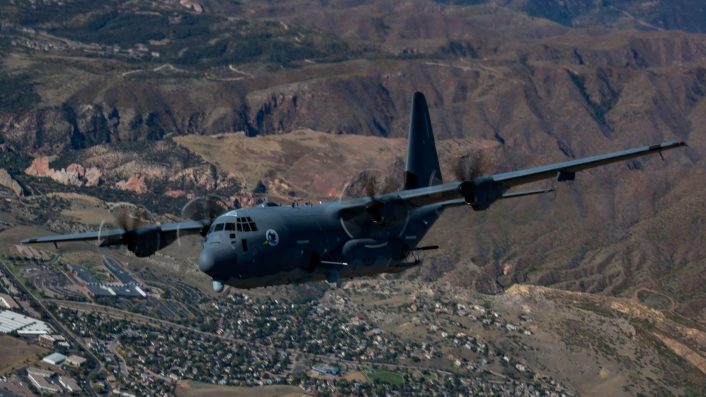35 Years Later, Retired AC-130H Spectre Crews Recount the Action from 1989âs âOperation Just Causeâ in Panama
The crew provided Close Air Support and precision fire power to the U.S. land forces on the ground in Panama. The attack also involved a series of precision strikes by F-117A Nighthawks.
Crews of AC-130H Spectre gunships that participated in the U.S. military intervention of Panama in 1989, called “Operation Just Cause”, returned to Hurlburt Field, Florida, from where they took off 35 years ago on Dec. 20, 1989 when the airlift began. Four retired U.S. Air Force personnel recounted the memories of their action against the Panama Defense Forces, hitting ground targets in a coordinated attack with other combined arms and air assets, including F-117A Nighthawk stealth attack aircraft.
Facing technical, weather and time constraints, the crew accomplished their mission to provide CAS (Close Air Support) and precision fire power to the U.S. forces which were on the ground for five days. They realized the criticality of their support only after meeting the exhausted U.S. Army Rangers as their military action subsided.
AC-130H_Spectre pic.twitter.com/Y8XTyoMbfS
— Skies-of-Glory (@violetpilot1) April 14, 2022
The group gained valuable tactical, technical, operational planning and logistical lessons in overhead fire support during wartime, which they said should be shared with current crews. The AC-130H Spectre aircraft itself went to evolve into the backbone of heavy aerial precision fire support as the new AC-130J Ghostrider, with more modern avionics and weaponry.
The AC-130H Spectre gunship’s crew, composed by Major Phil Lebrun, pilot, Sgt. Bill Walter, lead gunner, Master Sgt. Bill Jackson, low-light TV operator, and Lt. Col Ed Appler, navigator, is now retired, but they all shared their experiences in a feature by the AFSOC (Air Force Special Operations Command).
Deployment and action
The Aviationist reported in January 2024 how the 16th Special Operations Squadron conducted its final mission with the AC-130H Spectre at Cannon Air Force Base at New Mexico. In 2013, the Squadron completed its last AC-130H Spectre gunship deployment in Afghanistan after 40 years of active service all around the world.

Around dusk on Dec. 19, 1989, five AC-130H gunships, which Walter said were loaded with as much ammunition as possible, took off from Hurlburt Field for Panama. With each aircraft reaching up to 175,000 lb (79,378 kg) of weight, the aircraft required an “emergency wartime authorization” to waive off the maximum weight limitation.
After takeoff, each gunship crew performed a “tweak,” testing the weapons systems on board, followed by an aerial refuel to prepare for their arrival to Panama. The U.S. Air Force at the time used the McDonnell Douglas KC-10 Extender, that was introduced in the mid to late-1980s, and the older KC-135R Stratotanker.
From Hurlburt, the formation of the five gunships flew towards the Yucatán Channel, a strait located between Mexico and Cuba. Despite technical issues and challenging weather conditions, Walter said the gunships reached Panama ahead of time, doing their part to support the over 27,000 U.S. military personnel involved in Operation Just Cause.
Lebrun said it was key that they hit their targets “at the same time,” since if “one strike happened before another, it would have tipped off the Panamanian Defense Forces.” Each gunship crew planned a number of targets to engage to provide close air support and precision firepower for the U.S. ground forces below. These targets ranged from “anti-aircraft artillery to armed vehicles and key infrastructure, meant to disrupt enemy operations and ensure the safety of U.S. personnel.”
Spectre. An AC-130H gunship from the 16th Special Operations Squadron flies over the Florida coastline. (📷SrA Julianne Showalter/ Clemens Vasters) pic.twitter.com/DadK0jyzyz
— J.J. (@kadonkey) September 9, 2020
As the U.S. Air Force’s LeMay Center Doctrine Development reported in Feb. 2024 about Operation Just Cause, the airborne assault by the special operations forces was part of a “joint forcible entry” onto strategic installations in Panama. U.S. Army Rangers, Special Forces, and soldiers from the XVIII Airborne Corps boarded C-130, C-141, and C-5 aircraft at multiple locations across the United States to fly directly into the Central American country.
The attack was opened with a series of disabling, diversionary and precision strikes by EF-111A Ravens and F-117A Nighthawks. As per a report by the Joint History Office under the Chairman Joint Chiefs of Staff, the Air Force’s aircraft composition and numbers included two EF-111s for jamming, six EC-130s, eight AC-130 gunships, six F-117 stealth fighter bombers and other aircraft from the 1st Special Operations Wing. These were mostly units from the 830th Air Division.
During the action, the crews worked relentlessly to load and fire the aircraft’s 20 mm, 40 mm and 105 mm cannons. Sgt. Bill Jackson, the AC-130H low light-level TV operator, remembered how when they “first started shooting, (they) just fired away.” “Minutes went by and it felt like only a few seconds,” he added. For Jackson and Lt. Col. Ed Appler, Operation Just Cause marked their first-ever hostile engagement.

The crew “didn’t have time to think about the fight” and just had to “focus on doing their job and doing it well.” “We didn’t want to let our teammates down,” Appler said. The gunship crews ended up flying for as many as 18 hours, providing critical support for the ground forces below, the veterans explained.
The results and the importance of their actions emerged about five days later on the ground in Panama, as Jackson recounted seeing dozens of “dirt-ridden, exhausted” U.S. Army Rangers, and some of them stood up to shake the hands of the gunship crews. “They said we saved their lives,” Jackson explained. “Shaking their hands, I felt chills run up and down my spine.”
Post-operation assessment
As the CJSC’s JHO noted, strikes by aircraft like the AC-130H Spectres and other naval and ground heavy weapons under the OPLAN 90-2 (Operational Plan 90-2) were governed by “precise ROE (Rules of Engagement) to not hit hospitals, schools, churches, museums and historical monuments.” This was except for cases where these facilities were used by the enemy forces.
AC-130s and F-16 fighters were also tasked by the COMJSOTF (Commander Joint Special Operations Task Force) Major General Downing to intercept the aircraft of General Manuel Noriega, the country’s incumbent ruler, and force it to land, should he attempted to escape by air and the aircraft was detected by intelligence, radar or AWACS (Airborne Early Warning and Control System) aircraft. AC-130s were also required to assault Noriega’s hideout.

Reminiscing
In the hours leading up to Dec. 20, 1989, the group recalled preparing for the mission while keeping it a secret from their friends and families. “No one could know that we were leaving. It was all supposed to look like a big training exercise but we knew,” said Sgt. Bill Walter.
Today, as the crews reflect on the memories of Operation Just Cause, they don’t just relive the mission, but also pass on lessons learned with the next generation of gunship crews at Hurlburt Field.
Ultimately, all gunship crews share the same mission, Lebrun noted, adding that it’s important for them to share their experience with the current crews. “If you take a life and almost die, it sticks with you forever. Each person handles it differently. But, we are all trained to do our job and do it with vigor,” Lebrun said.
